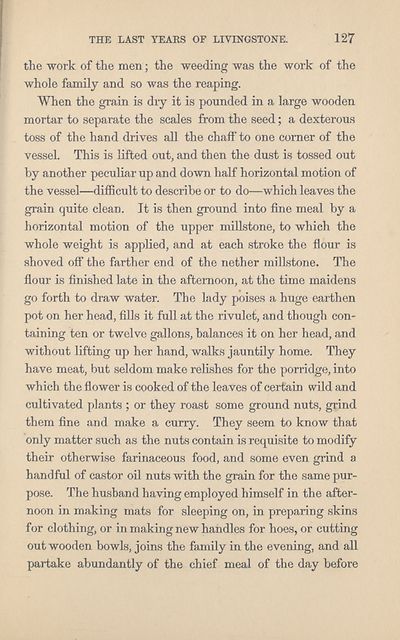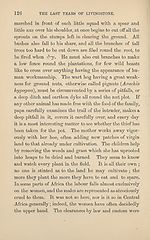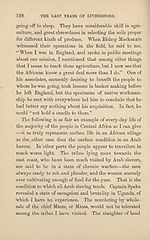Download files
Complete book:
Individual page:
Thumbnail gallery: Grid view | List view

THE LAST YEARS OF LIVINGSTONE. 127
the work of the men; the weeding was the work of the
whole family and so was the reaping.
When the grain is diy it is pounded in a large wooden
mortar to separate the scales from the seed; a dexterous
toss of the hand drives all the chaff to one comer of the
vesseh This is lifted out, and then the dust is tossed out
by another peculiar up and down half horizontal motion of
the vessel—difficult to describe or to do—which leaves the
grain quite clean. It is then ground into fine meal by a
horizontal motion of the upper millstone, to which the
whole weight is applied, and at each stroke the flour is
shoved off the farther end of the nether millstone. The
flour is finished late in the afternoon, at the time maidens
go forth to draw water. The lady poises a huge earthen
pot on her head, fills it full at the rivulet, and though con¬
taining ten or twelve gallons, balances it on her head, and
without lifting up her hand, walks jauntily home. They
have meat, but seldom make relishes for the porridge, into
which the flower is cooked of the leaves of certain wild and
cultivated plants ; or they roast some ground nuts, grind
them fine and make a curry. They seem to know that
only matter such as the nuts contain is requisite to modify
their otherwise farinaceous food, and some even grind a
handful of castor oil nuts with the grain for the same pur¬
pose. The husband having employed himself in the after¬
noon in making mats for sleeping on, in preparing skins
for clothing, or in making new handles for hoes, or cutting
out wooden bowls, joins the family in the evening, and all
partake abundantly of the chief meal of the day before
the work of the men; the weeding was the work of the
whole family and so was the reaping.
When the grain is diy it is pounded in a large wooden
mortar to separate the scales from the seed; a dexterous
toss of the hand drives all the chaff to one comer of the
vesseh This is lifted out, and then the dust is tossed out
by another peculiar up and down half horizontal motion of
the vessel—difficult to describe or to do—which leaves the
grain quite clean. It is then ground into fine meal by a
horizontal motion of the upper millstone, to which the
whole weight is applied, and at each stroke the flour is
shoved off the farther end of the nether millstone. The
flour is finished late in the afternoon, at the time maidens
go forth to draw water. The lady poises a huge earthen
pot on her head, fills it full at the rivulet, and though con¬
taining ten or twelve gallons, balances it on her head, and
without lifting up her hand, walks jauntily home. They
have meat, but seldom make relishes for the porridge, into
which the flower is cooked of the leaves of certain wild and
cultivated plants ; or they roast some ground nuts, grind
them fine and make a curry. They seem to know that
only matter such as the nuts contain is requisite to modify
their otherwise farinaceous food, and some even grind a
handful of castor oil nuts with the grain for the same pur¬
pose. The husband having employed himself in the after¬
noon in making mats for sleeping on, in preparing skins
for clothing, or in making new handles for hoes, or cutting
out wooden bowls, joins the family in the evening, and all
partake abundantly of the chief meal of the day before
Set display mode to:
![]() Universal Viewer |
Universal Viewer | ![]() Mirador |
Large image | Transcription
Mirador |
Large image | Transcription
| Antiquarian books of Scotland > Scotland/Scots > Last years of Livingstone > (135) |
|---|
| Permanent URL | https://digital.nls.uk/136058782 |
|---|
| Description | Thousands of printed books from the Antiquarian Books of Scotland collection which dates from 1641 to the 1980s. The collection consists of 14,800 books which were published in Scotland or have a Scottish connection, e.g. through the author, printer or owner. Subjects covered include sport, education, diseases, adventure, occupations, Jacobites, politics and religion. Among the 29 languages represented are English, Gaelic, Italian, French, Russian and Swedish. |
|---|

